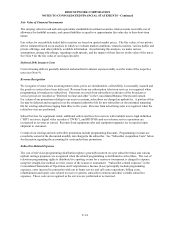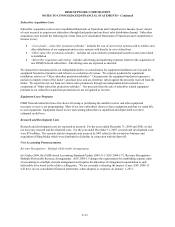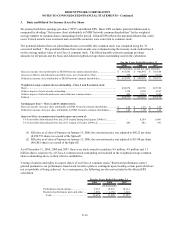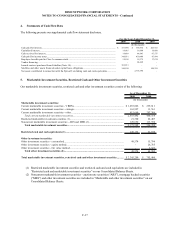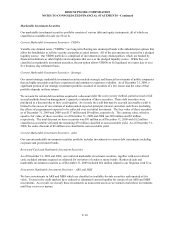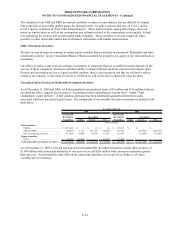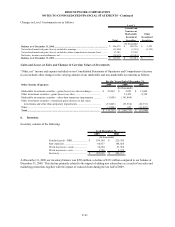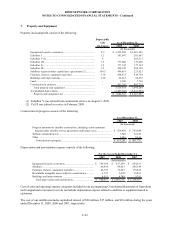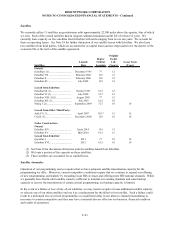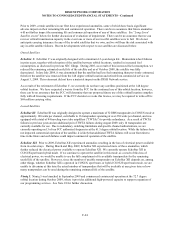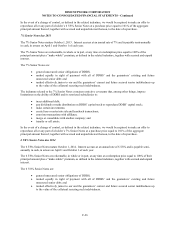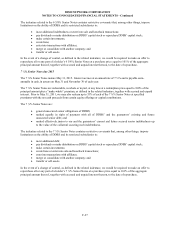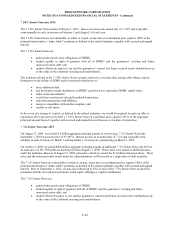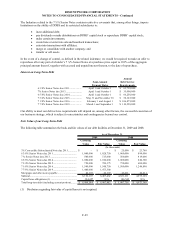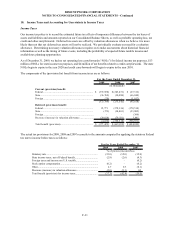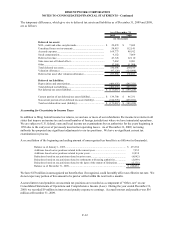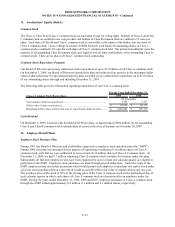Dish Network 2009 Annual Report Download - page 114
Download and view the complete annual report
Please find page 114 of the 2009 Dish Network annual report below. You can navigate through the pages in the report by either clicking on the pages listed below, or by using the keyword search tool below to find specific information within the annual report.
DISH NETWORK CORPORATION
NOTES TO CONSOLIDATED FINANCIAL STATEMENTS - Continued
F-24
Prior to 2009, certain satellites in our fleet have experienced anomalies, some of which have had a significant
adverse impact on their remaining life and commercial operation. There can be no assurance that future anomalies
will not further impact the remaining life and commercial operation of any of these satellites. See “Long-Lived
Satellite Assets” below for further discussion of evaluation of impairment. There can be no assurance that we can
recover critical transmission capacity in the event one or more of our in-orbit satellites were to fail. We do not
anticipate carrying insurance for any of the in-orbit satellites that we own, and we will bear the risk associated with
any in-orbit satellite failures. Recent developments with respect to our satellites are discussed below.
Owned Satellites
EchoStar V. EchoStar V was originally designed with a minimum 12-year design life. Momentum wheel failures
in prior years, together with relocation of the satellite between orbital locations, resulted in increased fuel
consumption, as disclosed in previous SEC filings. During 2005, as a result of this increased fuel consumption, we
reduced the remaining estimated useful life of the satellite and as of October 2008, the satellite was fully
depreciated. In late July 2009, it was determined that the satellite had less fuel remaining than previously estimated,
therefore the satellite was removed from the 148 degree orbital location and retired from commercial service on
August 3, 2009. This retirement did not have a material impact on the DISH Network service.
As a result of the retirement of EchoStar V, we currently do not have any satellites positioned at the 148 degree
orbital location. We have requested a waiver from the FCC for the continued use of this orbital location; however,
there can be no assurance that the FCC will determine that our proposed future use of this orbital location complies
fully with all licensing requirements. If the FCC decides to revoke this license, we may be required to write-off its
$68 million carrying value.
Leased Satellites
EchoStar III. EchoStar III was originally designed to operate a maximum of 32 DBS transponders in CONUS mode at
approximately 120 watts per channel, switchable to 16 transponders operating at over 230 watts per channel, and was
equipped with a total of 44 traveling wave tube amplifiers (“TWTAs”) to provide redundancy. As a result of TWTA
failures in previous years and an additional pair of TWTA failures during August 2009, only 14 transponders are
currently available for use. Due to redundancy switching limitations and specific channel authorizations, we are
currently operating on 13 of our FCC authorized frequencies at the 61.5 degree orbital location. While the failures have
not impacted commercial operation of the satellite, it is likely that additional TWTA failures will occur from time to
time in the future and such failures could impact commercial operation of the satellite.
EchoStar XII. Prior to 2009, EchoStar XII experienced anomalies resulting in the loss of electrical power available
from its solar arrays. During March and May 2009, EchoStar XII experienced more of these anomalies, which
further reduced the electrical power available to operate EchoStar XII. We currently operate EchoStar XII in
CONUS/spot beam hybrid mode. If we continue to operate the satellite in this mode, as a result of this loss of
electrical power, we would be unable to use the full complement of its available transponders for the remaining
useful life of the satellite. However, since the number of useable transponders on EchoStar XII depends on, among
other things, whether EchoStar XII is operated in CONUS, spot beam, or hybrid CONUS/spot beam mode, we are
unable to determine at this time the actual number of transponders that will be available at any given time or how
many transponders can be used during the remaining estimated life of the satellite.
Nimiq 5. Nimiq 5 was launched in September 2009 and commenced commercial operation at the 72.7 degree
orbital location during October 2009, where it provides additional high-powered capacity to support expansion of
our programming services. See Note 18 for further discussion.


